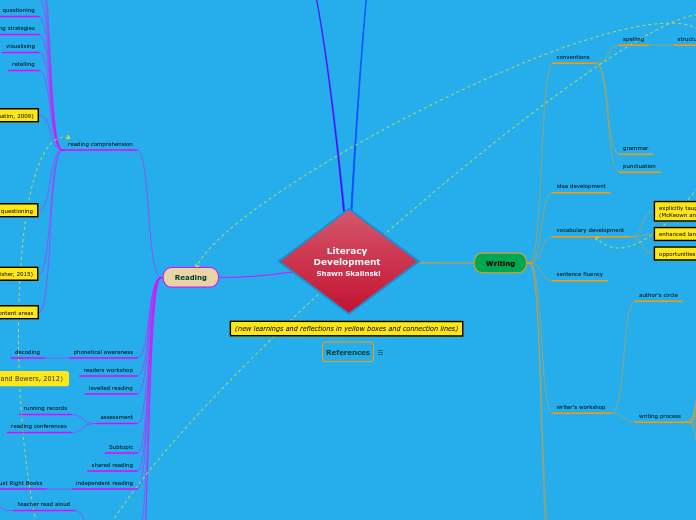Literacy Development Shawn Skalinski
Writing
conventions
spelling
structured word inquiry
graphemes
trigraphs
digraphs
single letter graphemes
phonemes
morphemes
bases
etymology
bound bases
prefixes
suffixes
matrices
marker vowels
grammar
punctuation
idea development
vocabulary development
explicitly taught -- ex. Sample Instructional Sequence (McKeown and Beck, 2011).
enhanced language as year progresses (Land & Allen, 2010)
opportunities to apply new language (Land & Allen, 2010)
sentence fluency
writer's workshop
author's circle
writing process
on demand prompt
brilliant beginnings
magnificent middles
excellent ends
publishing
self-regulating the writing process (Harris et al., 2013)
Goal setting SRSD (Harris et al., 2013)
30 minutes a day (Graham and Harris, 2016)
students write about topics they know about or have researched (Mayer, 2008)
3 components (Mayer, 2008)
planning
development of organization and generation of content
translation
converting ideas into words
reviewing
detection and correction of errors, internalize revision process
presentation
assessment
writing rubrics
writing conferences
Speaking
Read alouds
Text Talk: (Beck & McKeown, 2015)
Dialogic Thinking (Reading Rockets, 2014)
Main topic
Reading
reading comprehension
inferencing
recall
predicting
questioning
visible thinking strategies
visualising
retelling
Reciprocal Teaching ((Knatim, 2009)
summarizing
questioning
clarifying
predicting
Teacher-led questioning
lower to higher order questioning
QAR approach (Stahl, 2004)
Right There
Think and Search
Author and You
On My Own
Text consideration (Fisher, 2015)
Content areas
information and narrative text concept and vocabulary combination (Pollard et al., 2011)
vocabulary and concepts built around thematic units (Pollard et al., 2011)
phonetical awareness
decoding
readers workshop
levelled reading
assessment
running records
reading conferences
Subtopic
shared reading
independent reading
Just Right Books
read aloud
teacher read aloud
model prosody (Rasinski, 2011)
student read aloud
interactive storytelling
Repeated Reading (Faver, 2008)
guided reading
Morphology
